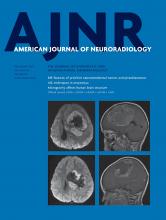Research ArticlePediatrics
Open Access
Signal Change in the Mammillary Bodies after Perinatal Asphyxia
M. Molavi, S.D. Vann, L.S. de Vries, F. Groenendaal and M. Lequin
American Journal of Neuroradiology November 2019, 40 (11) 1829-1834; DOI: https://doi.org/10.3174/ajnr.A6232
M. Molavi
aFrom the Departments of Radiology and Neonatology (M.M., L.S.d.V., F.G., M.L.), Wilhelmina Children's Hospital, University Medical Center Utrecht and Utrecht University, Utrecht, the Netherlands
S.D. Vann
bSchool of Psychology (S.D.V.), Cardiff University, Cardiff, UK
L.S. de Vries
aFrom the Departments of Radiology and Neonatology (M.M., L.S.d.V., F.G., M.L.), Wilhelmina Children's Hospital, University Medical Center Utrecht and Utrecht University, Utrecht, the Netherlands
F. Groenendaal
aFrom the Departments of Radiology and Neonatology (M.M., L.S.d.V., F.G., M.L.), Wilhelmina Children's Hospital, University Medical Center Utrecht and Utrecht University, Utrecht, the Netherlands
M. Lequin
aFrom the Departments of Radiology and Neonatology (M.M., L.S.d.V., F.G., M.L.), Wilhelmina Children's Hospital, University Medical Center Utrecht and Utrecht University, Utrecht, the Netherlands

References
- 1.↵
- Vann SD
- 2.↵
- Sziklas V,
- Petrides M
- 3.↵
- Vann SD,
- Aggleton JP
- 4.↵
- Kopelman MD
- 5.↵
- Tsivilis D,
- Vann SD,
- Denby C, et al
- 6.↵
- Kumar R,
- Birrer BVX,
- Macey PM, et al
- 7.↵
- Bernstein HG,
- Krause S,
- Krell D, et al
- 8.↵
- de Vries LS,
- Groenendaal F
- 9.↵
- Alderliesten T,
- Nikkels PG,
- Benders MJ, et al
- 10.↵
- 11.↵
- Maneru C,
- Serra-Grabulosa JM,
- Junque C, et al
- 12.↵
- Gadian DG,
- Aicardi J,
- Watkins KE, et al
- 13.↵
- 14.↵
- 15.↵
- 16.↵
- 17.↵
- Schmidtke K
- 18.↵
- Cowan F,
- Rutherford M,
- Groenendaal F, et al
- 19.↵
- Alderliesten T,
- de Vries LS,
- Benders MJ, et al
- 20.↵
- Alderliesten T,
- de Vries LS,
- Staats L, et al
- 21.↵
- 22.↵
- 23.↵
- 24.↵
- Papez JW
- 25.↵
- 26.↵
- Froudist-Walsh S,
- Browning PGF,
- Croxson PL, et al
- 27.↵
- Vortmeyer AO,
- Hagel C,
- Laas R
- 28.↵
- Kumar R,
- Woo MA,
- Birrer BVX, et al
- 29.↵
- 30.↵
- Kornreich L,
- Bron-Harlev E,
- Hoffmann C, et al
- 31.↵
- Zuccoli G,
- Siddiqui N,
- Bailey A, et al
- 32.↵
- Dillingham CM,
- Milczarek MM,
- Perry JC, et al
- 33.↵
- 34.↵
- 35.
- Denby CE,
- Vann SD,
- Tsivilis D, et al
In this issue
American Journal of Neuroradiology
Vol. 40, Issue 11
1 Nov 2019
Advertisement
M. Molavi, S.D. Vann, L.S. de Vries, F. Groenendaal, M. Lequin
Signal Change in the Mammillary Bodies after Perinatal Asphyxia
American Journal of Neuroradiology Nov 2019, 40 (11) 1829-1834; DOI: 10.3174/ajnr.A6232
0 Responses
Jump to section
Related Articles
Cited By...
This article has been cited by the following articles in journals that are participating in Crossref Cited-by Linking.
- K.M.E. Meys, L.S. de Vries, F. Groenendaal, S.D. Vann, M.H. LequinAmerican Journal of Neuroradiology 2022 43 6
- Corline E J Parmentier, Sylke J Steggerda, Lauren C Weeke, Monique Rijken, Linda S De Vries, Floris GroenendaalArchives of Disease in Childhood - Fetal and Neonatal Edition 2022 107 4
- Michal M. Milczarek, James C. Perry, Eman Amin, Salma Haniffa, Thomas Hathaway, Seralynne D. VannScientific Reports 2024 14 1
- Maarten Lequin, Lisanne M. Baak, Jeroen Dudink, Seralynne Vann, Floris Groenendaal, Linda S. de Vries, Manon J.N.L. Benders, Cora H.A. Nijboer, Nienke Wagenaar, Niek E. van der AaNeurology Open Access 2025 1 1
- Katsumi HAYAKAWA, Koichi TANDA, Akira NISHIMURA, Daisuke KINOSHITA, Masakazu NISHIMOTO, Yuko SANOJapanese Journal of Magnetic Resonance in Medicine 2022 42 4
More in this TOC Section
Similar Articles
Advertisement











